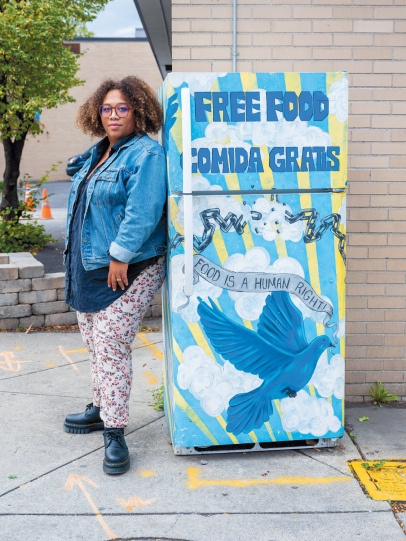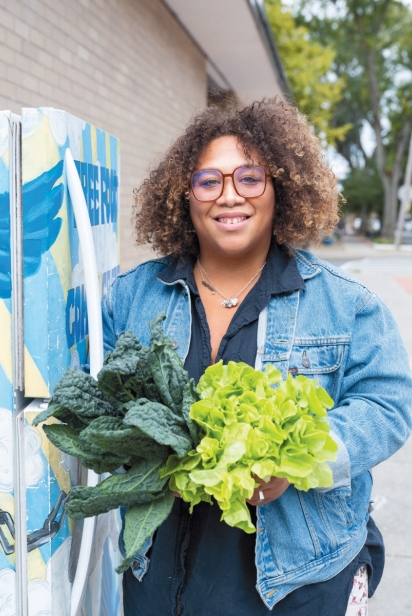Free Food Fridge Albany Creates a Space for Give and Take
First came the pandemic, then the War in Ukraine, then inflation. One issue alone would have had a serious impact on the global food system; put together, the trio became a cataclysmic catastrophe, with devastating effects for underserved populations in every nation under the sun.
The pressure on supply chains and the resulting surge in food prices has put a stranglehold on more than 345 million necks across the world, whose lives are now at risk due to acute food insecurity, according to the World Bank. If not dealt with immediately, reduced caloric intake and poor nutrition may have lasting impacts on children’s brain development, the effects of which threaten to set progress made in recent decades on poverty reduction back generations, the World Bank warns.
For decades, as distressing as it was, acute hunger and severe food insecurity often felt far away for many of us. But in reality, these problems have always existed in our community, and the pandemic, the war and inflation have exacerbated them enough to push the dark secret into the light.
“During the pandemic, it became increasingly clear that people living amid food apartheid in the Capital Region were going hungry,” says Jammella Anderson, an activist, doula and yoga teacher who took it upon themselves to launch Free Food Fridge Albany in the summer of 2020 in response to the need they saw. “The problem isn’t having enough food to feed people here, the problem is giving the people who are hungry access to the food that will otherwise end up in the landfill.”
More than 2.1 million residents in New York State are food insecure—that’s more than 10.7% of the state’s population, according to data from Feeding America. And yet, as Anderson pointed out, their hunger isn’t due to a lack of food.
The U.S. discards more perfectly good food than any other country in the world—an estimated 40 million tons (that’s 80 billion pounds) annually, according to Recycle Track Systems. That waste accounts for up to 40% of the entire nation’s food supply, and roughly equates to every single citizen standing in front of a garbage dump and pitching 650 crisp, freshly plucked apples onto the stinking pile of refuse, to rot and disintegrate.
Wouldn’t it make more sense to put that food in hungry bellies? That’s where the problem of food apartheid comes in.
“There are many communities in the Capital Region, many of which are Black and Brown, that don’t have access to healthy food,” Anderson says. “And it’s not just healthy food, it’s food in general.”
Anderson explains that the Free Food Fridges concept has existed for years. The Black Panther movement had a Free Breakfast Program, which started in Oakland, California, in 1969. Anderson was inspired to create their own chapter in Albany shortly after the pandemic began.
“It was one of those things where I realized that if I didn’t just go ahead and do it here, maybe no one would,” they say. “But I also thought that people would want to help, and I saw not just a need, but a solution—how could I not try?”
Anderson initially approached the Free School at 8 Elm Street in Albany, the longest running inner-city independent alternative school in the country.
A Community That Gives and Takes
“They were ecstatic about the opportunity to feed people,” they say. Anderson plugged in a household-size fridge and stocked it with donated food. (Anderson’s many years of activism in the housing space, and the network of contacts and allies they have created, helped them get the Free Fridge project up and moving, fast.)
“We don’t have locks, and we don’t ask questions or put a limit on how much people can take,” Anderson explains. “Some people take more than others, but that’s because they may be feeding large families, or neighbors. If they need the food, they are welcome to it. We see ourselves as a pantry alternative, and a supplement to pantries, so we try to put food that is straight from the ground and unprocessed in the fridge. Nothing packaged or in boxes.”
Anderson donated—and continues to donate—their time to the project, but as they intuited, the community has rallied around Free Fridge Albany, helping to turn it into a hunger-slaying juggernaut.
“I’ve been able to install 10 fridges across the Capital Region in Albany, Troy and Schenectady,” they say. “Most places are happy to provide a free outlet for the fridge and space for people who are hungry to come and pick up food. Individuals have donated tens of thousands of dollars since I launched Free Fridge, and several farms, food co-ops and companies also donate produce, dairy products and eggs.”
Anderson coordinates pickups and drop-off s from Fort Ferry Farm, Honest Weight Co-Op and Feed Albany, among many other eager partners, on a weekly basis. Anderson recently teamed up with Schenectady Community Ministries Urban Farms on a renewable energy initiative that provides solar power to a Schenectady fridge.
“I am happy to see how generous the community has been, and the help is more needed than ever,” Anderson says. “I would say we are in a worse spot now with inflation than we were in with the pandemic. More and more people are now not just food insecure but home-insecure. It’s impossible to make generalizations though. The problem is becoming bigger, and you can’t make generalizations about what a food or house insecure person’s life looks like. They come from all walks of life.”
While Anderson says that Free Fridge Albany’s inherent anonymous nature makes counting the number of individuals accessing the fridge difficult, they guesstimate that hundreds of people do so every week.
“Across the region sometimes a few fridges will need to be refilled a few times a day, whereas a few others will need a refill a few times a week, but then it will flip and the need in one neighborhood will seemingly rise,” they observe.
Anderson was recently able to hire someone part-time to help them coordinate volunteers and food donations. Free Fridge Albany is a 501c3, and donations of time and money are needed to keep the operation running. Check out our sidebar for more information.
“I’ve been asked so many times about who owns this or that fridge,” Anderson says. “The truth is, our fridges belong to the community. It’s yours to give to, or take from.”
How to Help Free Food Fridge Albany
Learn more at:
FreeFoodFridgeAlbany.com
Donate on any of these apps:
Patreon // freefoodfridgealbany
PayPal // freefoodfridgealbany@gmail.com
Venmo // freefoodfridgealbany
Or reach out to
freefoodfridgealbany@gmail.com
Stock the Fridge:
Do not drop off food from your home or business at fridges. Instead, contact Free Fridge to coordinate donations. Anderson is looking for farmers and restaurants looking to donate excess food, and also restaurants willing to provide ready-to-eat meals for takeaway. Contact freefoodfridgealbany@gmail.com for more information.
Donate Your Time:
Free Fridge Albany is always looking for volunteers! Anderson explains that some extended families and friend groups will “split” drop-off and pickup duties for one fridge. “It’s a great way for families to work together,” Anderson notes. “One of our families splits it so one or two people stock the fridge on a rotating basis. It is something they love doing as a unit, and it reduces the time commitment for everyone involved.”
Host a Fridge:
If you own a business and want to get involved, reach out at freefoodfridgealbany@gmail.com.
Learn more:
worldbank.org/en/topic/agriculture/brief/food-security-update
foodbanknyc.org/research-reports
rts.com/resources/guides/food-waste-america






